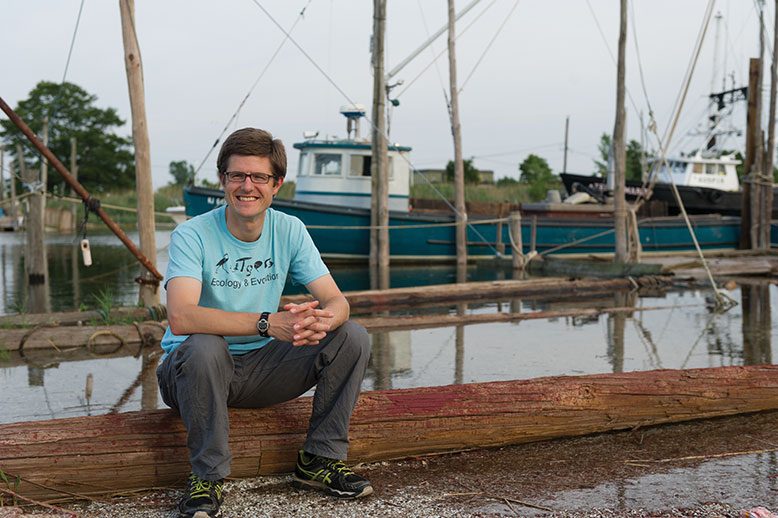
In Malin Pinsky’s lab, they keep the unicorn blood in the fridge. It sits alongside dozens of small, white boxes, each containing a snippet of fin or other tissue from the clownfish and summer flounder that, together, may help Pinsky and his colleagues determine the answer to a critical question about the world’s changing oceans. In fact, the unicorn blood—so dubbed by lab manager Michelle Stuart because, Pinsky explains, “it’s expensive and it works magic”—is actually a stew of enzymes used to purify DNA from those fish samples.
The DNA helps Pinsky and his team at Rutgers University in New Brunswick track the movement of fish species over time. What they are finding is likely to have major implications for the commercial and recreational fishing industries in New Jersey and around the world.
For decades, scientists have observed a northward shift in the ranges of many land-based animals in response to a warming climate, among them birds and butterflies. In addition, some mountain-dwelling species, like the pika, a cousin of the rabbit native to the Western United States, have moved to higher altitudes, chasing the cooler temperatures to which they have adapted over millions of years of evolution. Among these observations are scattered reports of the same thing happening in warming ocean waters.
As a marine biologist, Pinsky had read the reports. Concerned about how widespread the changes might be, he and his colleagues ran the first stage of an ongoing research project from 2011 to 2013. The results were startling. “Not only are many species of marine animals, from cod to flounder to lobster, moving to new locations,” says Pinsky, “but it’s happening very rapidly, and it’s affecting a wide range of fisheries, both commercial and recreational.”
Analyzing data collected annually by the National Marine Fisheries Service and its partners, Pinsky’s lab launched the website OceanAdapt, which charts the changing ranges of a wide variety of marine species, regionally and nationally. The site’s graphs depict changes in latitude and sea depth. On a species-by-species basis, those changes are not particularly striking; it’s long been known that fish move around a lot from year to year. But when considering the marine life community as a whole, one observes an indisputable trend northward and downward (to greater depths).
Consider the summer flounder. Once found in large numbers off the coast of North Carolina, summer flounder (also known as fluke) have shifted their range to the north over the past several decades and are now one of the most popular species among recreational anglers along the Jersey Shore. Some of that shift, notes Pinsky, is likely the result of the recovery of the species. Fish often expand their range as their numbers grow, and summer flounder, overfished in the early 1990s, have rebounded. “But warming temperatures,” he says, “also seem to be playing a role.”
Another species on the move is black sea bass, which appear to be forsaking their traditional range off the coast of Virginia for the more hospitable waters off New Jersey and north to the Gulf of Maine. Lobsters are virtually gone from Long Island Sound, but are wildly abundant in the waters off Maine. Maine steadily produced approximately 20 million pounds of lobster annually from 1950 through 1990. In the last five years that number has grown to nearly 125 million pounds per year. And halibut, long found in the Bering Sea off Alaska, seem to be moving northward.
New Jersey may be benefiting from the influx of summer flounder and black sea bass, but the state has already lost other forms of marine life that were once important to its commercial fishing industry. Over the past several decades, for instance, the small, silver-scaled fish known as silver hake whiting have shifted their range into New England. Surf clams, not long ago a mainstay for New Jersey’s commercial clammers, are increasingly hard to find in our waters.
While those who study marine life or earn their living from it have not reached a consensus on what’s driving this northward migration, warming waters are often cited as the culprit. There’s virtually no doubt that the oceans are, indeed, heating up. “We all know the ocean water is warming out here, because we’re on the water a lot,” says Jeff Kaelin, responsible for government relations at Lund’s Fisheries, a commercial fishing operation in Cape May.
The National Oceanic and Atmospheric Administration estimates that, since 1880, sea-surface temperatures have risen by 0.81 degrees celsius. If that number seems insignificant, consider that fish and other marine organisms are exquisitely sensitive to changes in temperature. “Fish,” says marine biologist Richard Seagraves, “are ectotherms”—meaning that they derive their body temperature from their surroundings. “They do best in certain temperature ranges and seek those out.”
As senior scientist for the Mid-Atlantic Fishery Management Council (MAFMC), one of the councils charged with overseeing U.S. fisheries (designated areas where fish are routinely caught), Seagraves is well aware of the risk these shifts in habitat pose to commercial fishermen. For decades, the councils have set state-by-state quotas for certain fish based on traditional species ranges. Fishermen coming ashore in North Carolina, for instance, are allowed to land a certain tonnage of summer flounder each time they go out; the same is true for New Jersey. The system works well when fish remain in their historical ranges but starts to unravel when the fish don’t cooperate.
That’s one of the reasons that large commercial fishing operations like Lund’s hold permits from a variety of states. Their boats can catch fluke in the New York Bight, 19,000 square miles of ocean extending from Cape May to Montauk Point and offshore to the Continental Shelf, then bring them south so they can be landed in North Carolina, which allows fishermen a bigger catch. Given the extra fuel burned on those trips to North Carolina, the process is costly on an economic and environmental level. “That’s sort of the cost of doing business right now,” says Kaelin.
Unfortunately, it’s a cost that smaller operations and single-boat fishermen can’t easily bear. “Those who have larger boats are happy to move up and down the coast to follow the fish,” says Pinsky. “The smaller boats that just go out for a day? Not so happy about the changes.”
Fisheries managers are starting to address the problems posed by habitat shift. On the agenda for the MAFMC’s meeting in June, in addition to issues like surf clam and ocean-quahog assessments, was a discussion titled “Climate Velocity Over the 21st Century and Its Implications for Fisheries Management in the Northeast U.S.” As a tool for fisheries managers and scientists, the NOAA recently introduced new methodology for assessing whether particular fish species are vulnerable to climate change. The MAFMC has already adopted guidelines to help it integrate questions of climate change when setting fishing rules. Other fisheries managers are likely to follow suit.
Still, no one has determined the perfect approach for dealing equitably with a changing ocean. Seagraves calls the move to a new protocol at the MAFMC “an evolutionary-type thing.” The council recently funded an assessment of butterfish that found the stock was larger than believed “by an order of magnitude,” Seagraves says. This happens to be a good thing for New Jersey’s commercial fishermen, who can now land more of the fish, popular for the buttery flavor from which its name derives. But as fishery managers continue to adopt the approach, the news on various species is likely to be mixed.
A new approach to assessing fish stocks will almost certainly benefit both fishermen and fish species. But a changing marine environment poses dangers beyond its effects on fisheries management and commercial fishing. When a species is in the process of colonizing a new part of the ocean, Pinsky notes, its population in the new area tends to be small, making it extremely vulnerable to overfishing. And movement into foreign territory, where species may face new predators or struggle to find food, is inherently risky. It could also be risky for the entrenched species. Pinsky hypothesizes, for example, that black sea bass, in moving northward, are developing a taste for the lobster they’re encountering in their new habitat and could become a significant predator for the crustacean. In addition, fish are an important source of food for land animals. Summer flounder, for instance, are a favorite of ospreys. If summer flounder continue moving northward and ospreys don’t follow, the birds—including those nesting in New Jersey—could lose an important food source.
As the rate of ocean warming picks up, says Pinsky, “these kinds of changes are likely to continue, if not accelerate.” When asked if there’s a possibility of stopping that acceleration, he laughs somewhat ruefully. “Definitely,” he says. “These changes are driven by the giant blanket that we are wrapping around the Earth right now. The biggest thing we could do is to reduce greenhouse-gas emissions.”
If we don’t have the political will to do that, we could be in store for a cascading series of marine crises. Fish under stress from warming, for example, are likely to be smaller, and smaller fish generally produce fewer eggs. Couple lower reproduction with overfishing, and we could be seeing an increasing number of local extinctions. In addition, as waters warm, the timing of annual events like spawning and migration could change; fish whose feeding patterns are linked to those events could be faced with critical food shortages, which would likely stress species even further.
“Marine ecosystems are like a snow globe,” says Pinsky, “and we’ve just shaken it really hard, and everything’s swirling around, and we’re not quite sure how it’s going to settle out.” He and his colleagues have a sense of what he calls “the broad outlines of what’s happening and what’s going to happen” in the oceans we all depend on. But, he concludes, “there will almost certainly be big surprises.”
Leslie Garisto Pfaff is a longtime contributor and winner of two 2017 reporting awards from the New Jersey chapter of the Society of Professional Journalists.



